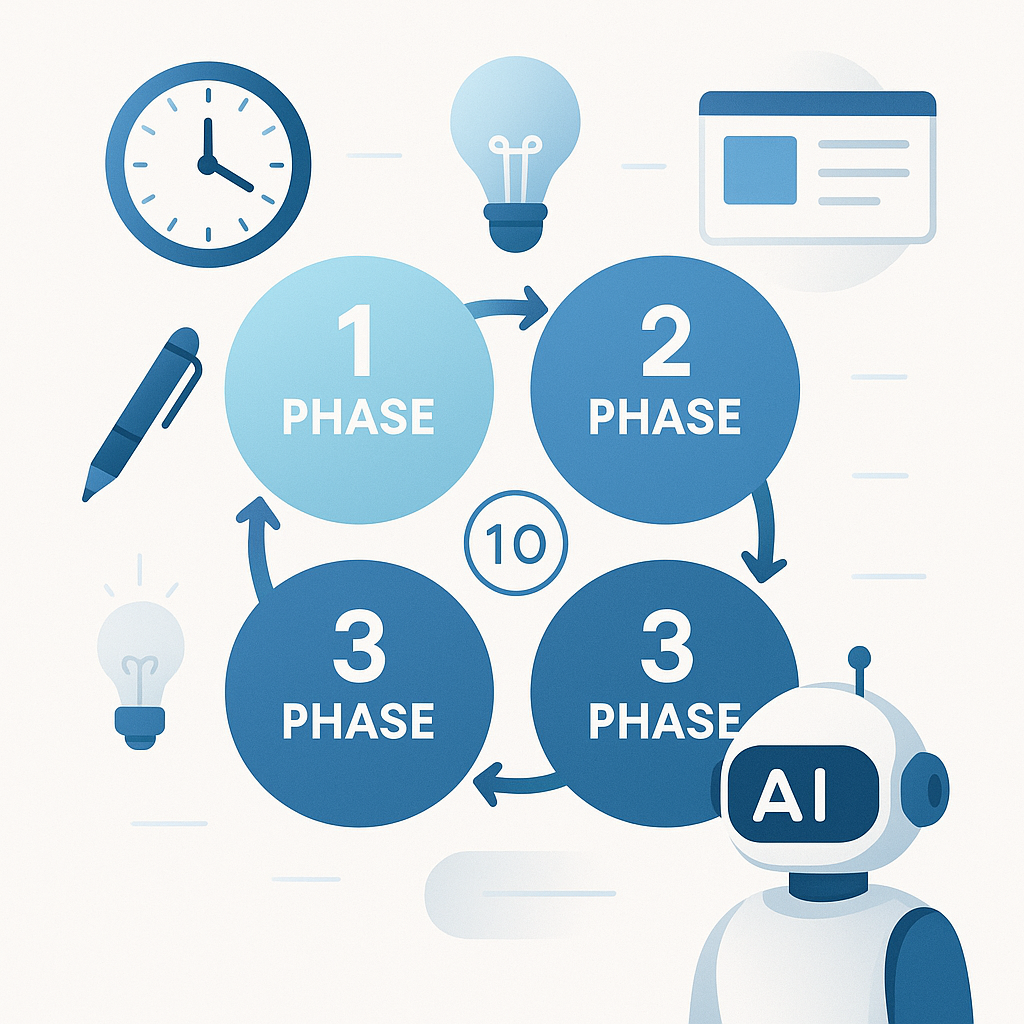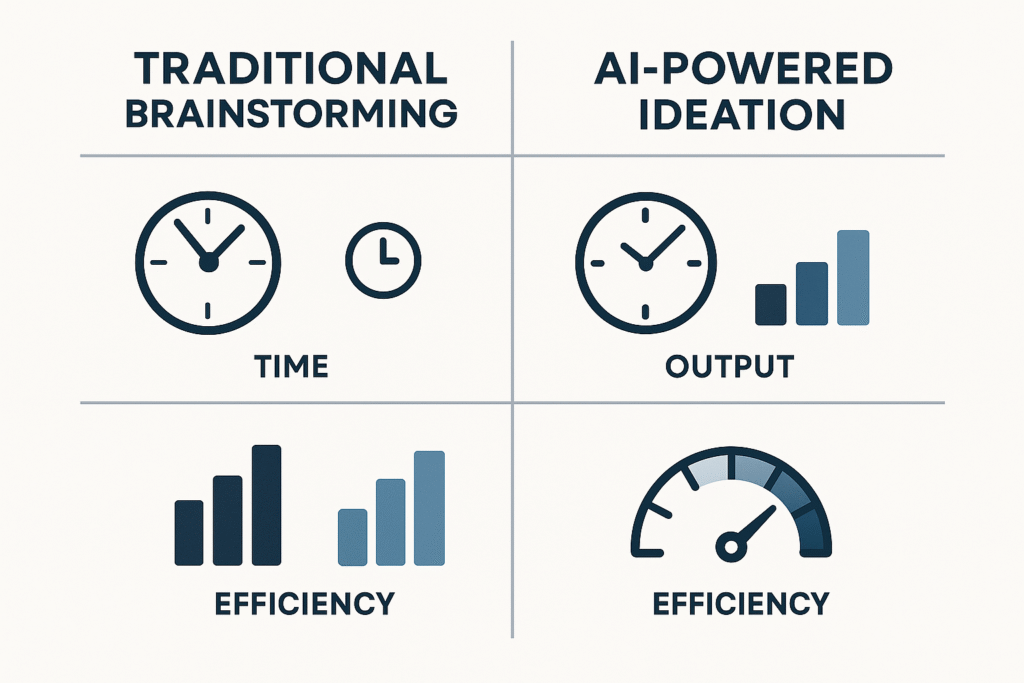Never run out of content ideas again. This systematic approach uses AI to generate endless blog topics tailored to your niche, audience, and SEO goals. Includes 50+ proven prompts and a complete ideation framework.

Transform your content planning with this systematic AI ideation approach
Introduction: The Blog Idea Drought is Over
Every blogger faces the same nightmare: staring at a blank screen, desperately trying to come up with their next post idea. Traditional brainstorming methods are slow, often producing generic topics that don’t resonate with your audience or rank in search results.
But what if you could generate 100 targeted, SEO-optimized blog ideas in just 10 minutes?
With the right AI prompting strategy, this isn’t just possible—it’s become my standard weekly routine. In this comprehensive guide, I’ll share the exact system I use to create months of content ideas in minutes, complete with ready-to-use prompts and strategic frameworks.

What You’ll Learn:
– The 4-phase AI ideation system that generates unlimited topics
– 50+ tested prompts for different content types and niches
– How to validate and prioritize your AI-generated ideas
– Advanced strategies for seasonal and trending content
– Tools and workflows to organize your content pipeline
The Traditional Problem with Blog Idea Generation
Why Manual Brainstorming Fails:
– Time-Intensive: Hours spent for just a few mediocre ideas
– Limited Perspective: Stuck in your own knowledge bubble
– No SEO Consideration: Ideas that don’t match search intent
– Generic Results: Topics everyone else is already covering
– Inconsistent Quality: Some great ideas mixed with many poor ones
The AI Advantage:
– Speed: 100+ ideas generated in minutes
– Diversity: Perspectives beyond your immediate knowledge
– SEO Integration: Keywords and search intent built-in
– Data-Driven: Based on actual search trends and user behavior
– Scalable: Unlimited ideation capacity

AI ideation delivers 10x faster results with better quality and SEO optimization
The 4-Phase AI Ideation System
Phase 1: Audience Analysis & Niche Mapping (2 minutes)
Phase 2: Core Topic Generation (3 minutes)
Phase 3: Content Type Diversification (3 minutes)
Phase 4: SEO Optimization & Validation (2 minutes)

Complete framework for generating unlimited blog topics in just 10 minutes
Let’s dive into each phase with specific prompts and strategies.
Phase 1: Audience Analysis & Niche Mapping (2 minutes)
Before generating topics, AI needs to understand your audience and niche deeply. This foundation ensures every idea targets real user needs.
Prompt 1: Audience Pain Point Analysis
“`
“I run a blog about [your niche]. Help me identify the top 10 pain points, challenges, and frustrations my target audience faces. For each pain point, explain:
– Why it’s a significant problem
– What solutions currently exist
– What gaps remain unaddressed
– How urgent/important it is to solve
My target audience: [describe your audience – demographics, interests, skill level]”
“`
Prompt 2: Content Gap Discovery
“`
“Analyze the content landscape for [your niche] and identify 10 topic areas that are:
– Underserved by current content
– High-interest to [your audience]
– Suitable for blog format
– Have commercial potential
For each gap, suggest why it’s underserved and what unique angle I could take.”
“`
Prompt 3: Competitor Analysis
“`
“I want to create better content than my competitors in [your niche]. Research the top 5 blogs in this space and identify:
– Their most popular content types
– Topics they cover repeatedly
– Subjects they avoid or handle poorly
– Opportunities for more comprehensive coverage
– Angles they haven’t explored
Use this analysis to suggest content opportunities.”
“`
Phase 2: Core Topic Generation (3 minutes)
With your audience insights, now rapidly generate core topics across multiple content categories.

Real AI prompts in action – generating targeted blog topics for any niche
Prompt 4: How-To Content Ideas
“`
“Generate 20 ‘how-to’ blog post ideas for [your niche] that:
– Solve specific problems for [your audience]
– Can be completed with actionable steps
– Include both beginner and advanced topics
– Have strong search potential
Format each as a compelling headline with estimated difficulty level (Beginner/Intermediate/Advanced).”
“`
Prompt 5: List-Based Content
“`
“Create 15 list-based blog post ideas for [your niche] including:
– ‘Best of’ lists (tools, resources, examples)
– ‘Top X Ways to…’ posts
– Comprehensive resource roundups
– Comparison lists
– Mistake/pitfall lists
Ensure each targets different user intents and includes suggested list lengths.”
“`
Prompt 6: Trend-Based Topics
“`
“Based on current trends in [your niche] for 2025, generate 15 blog post ideas that:
– Address emerging technologies or methods
– Predict future developments
– Analyze current market changes
– Provide trend-based advice
– Help readers prepare for what’s coming
Include why each trend is relevant and timely.”
“`
Prompt 7: Problem-Solution Framework
“`
“For each of these common problems in [your niche], suggest 2-3 blog post angles:
Problem 1: [specific problem your audience faces]
Problem 2: [another specific problem]
Problem 3: [third specific problem]
Problem 4: [fourth specific problem]
Problem 5: [fifth specific problem]
For each angle, explain the unique value proposition and target keyword potential.”
“`
Prompt 8: Question-Based Content Generator
“`
“Generate 25 blog post ideas based on questions your audience asks about [your niche]. Structure them as:
– ‘What is…’ (definitional content)
– ‘How does…’ (explanatory content)
– ‘Why do…’ (analytical content)
– ‘When should…’ (timing/strategy content)
– ‘Where can…’ (resource/location content)
Each should target featured snippet opportunities and voice search queries.”
“`
Prompt 9: Seasonal Content Planner
“`
“Create a 12-month content calendar for [your niche] with seasonal blog post ideas:
– Monthly themes relevant to [your niche]
– Holiday-related content opportunities
– Industry event tie-ins
– Seasonal problem-solving content
– Year-end/New Year planning posts
Include timing recommendations and suggested keywords for each season.”
“`
Phase 3: Content Type Diversification (3 minutes)
Transform your core topics into diverse content formats that serve different user preferences and search intents.
Prompt 10: Content Format Matrix
“`
“Take these 5 core topics: [list 5 topics from Phase 2]
For each topic, create blog post variations in these formats:
– Ultimate/Complete Guide (3000+ words)
– Quick Tips/Hacks (800-1200 words)
– Case Study (1500-2000 words)
– Beginner’s Guide (2000-2500 words)
– Advanced Strategy Post (2500+ words)
Provide compelling headlines and brief descriptions for each variation.”
“`
Prompt 11: Interactive Content Ideas
“`
“Generate 15 interactive blog post ideas for [your niche] that include:
– Calculator/tool-based posts
– Quiz and assessment content
– Template and worksheet posts
– Checklist-driven articles
– Interactive comparison guides
For each idea, explain what interactive element would be included and why it adds value.”
“`
Prompt 12: Storytelling and Case Study Generator
“`
“Create 10 story-driven blog post ideas for [your niche] including:
– Success stories and transformations
– Failure analysis and lessons learned
– Behind-the-scenes content
– Personal journey narratives
– Industry case studies
Each should include a clear lesson or takeaway for readers and potential for emotional engagement.”

“`
Prompt 13: Comparison and Review Content
“`
“Generate 12 comparison and review blog post ideas for [your niche]:
– Tool vs tool comparisons
– Method vs method analysis
– Product review roundups
– Service provider comparisons
– Strategy comparison posts
– Before/after analysis
Include suggestions for evaluation criteria and what makes each comparison unique.”
“`
Phase 4: SEO Optimization & Validation (2 minutes)
Refine your AI-generated ideas for maximum search visibility and user value.
Prompt 14: Keyword Integration Optimizer
“`
“For these 10 blog post ideas: [list 10 favorites from previous phases]
Suggest:
– Primary target keyword for each
– 3-5 related secondary keywords
– Long-tail keyword variations
– Search intent classification (informational/commercial/navigational)
– Estimated competition level
Prioritize based on SEO opportunity vs. competition.”
“`
Prompt 15: Content Angle Refinement
“`
“Improve these blog post ideas by adding unique angles that differentiate them from existing content:
[List 10-15 ideas you want to refine]
For each, suggest:
– A unique perspective or approach
– Specific data or research to include
– Personal experience elements to add
– Visual content opportunities
– Potential for social media amplification
Focus on angles that showcase expertise and provide genuine value.”
“`
Prompt 16: Featured Snippet Optimizer
“`
“Transform these blog topics into featured snippet opportunities:
[List 8-10 promising topics]
For each topic, suggest:
– Question format that targets featured snippets
– Answer structure (paragraph, list, or table)
– Key information to include in the snippet
– Related questions for ‘People Also Ask’ sections
– Voice search optimization potential
Format suggestions to maximize snippet capture probability.”
“`
Advanced AI Ideation Strategies
Strategy 1: Niche Intersection Method
Prompt 17: Cross-Niche Topic Generator
“`
“Generate blog post ideas at the intersection of [your primary niche] and these secondary topics:
– Technology trends
– Business strategy
– Personal development
– Industry news
– Environmental concerns
– Economic factors
Create 15 ideas that blend these areas naturally while serving my core audience.”
“`
Strategy 2: Audience Journey Mapping
Prompt 18: Customer Journey Content Planner
“`
“Map blog content ideas to different stages of the customer journey for [your niche]:
Awareness Stage (8 ideas):
– Problems they’re just discovering
– Educational/informational content
– Industry overview topics
– Trend awareness posts
Consideration Stage (8 ideas):
– Solution comparison content
– ‘How to choose’ guides
– Evaluation criteria posts
– Feature explanation content
Decision Stage (6 ideas):
– Implementation guides
– Success stories/case studies
– Getting started tutorials
– Onboarding content
Post-Purchase (3 ideas):
– Advanced techniques
– Optimization strategies
– Community/networking content
Ensure each stage has appropriate content depth and call-to-action suggestions.”
“`
Strategy 3: Content Recycling and Updates
Prompt 19: Content Refresh Generator
“`
“Suggest ways to refresh and expand existing content in [your niche]:
– Update old ‘best of’ lists with new options
– Expand previous posts into comprehensive guides
– Create follow-up posts to popular content
– Address comments and questions from previous posts
– Create ‘X years later’ retrospective posts
– Turn popular posts into series or courses
Generate 12 specific content refresh ideas that could breathe new life into older topics.”
“`
Expert-Level Prompting Techniques
Advanced Prompt 20: Competitor Gap Analysis
“`
“Perform a competitive content analysis for [your niche]. Identify 15 blog post opportunities where:
1. Competitors have shallow coverage of important topics
2. Popular topics lack comprehensive, up-to-date information
3. Technical subjects need beginner-friendly explanations
4. Trending topics haven’t been thoroughly explored
5. Local/regional angles are underserved
For each opportunity, explain:
– Why current content is insufficient
– What unique value I could provide
– Estimated difficulty to rank
– Potential for backlinks and social shares
– Commercial opportunity assessment”
“`
Advanced Prompt 21: Trend Prediction Content
“`
“Based on current patterns in [your niche], predict future trends and create blog post ideas around:
Emerging Technologies:
– Tools and platforms gaining traction
– New methodologies being developed
– Automation opportunities
– Integration possibilities
Market Shifts:
– Changing user behaviors
– Economic impacts on the industry
– Regulatory changes affecting the space
– Demographic shifts in audience
Content Opportunities:
– Early adoption guides
– Prediction and analysis posts
– Preparation strategies
– Future-proofing advice
Generate 10 forward-thinking blog post ideas with timeline predictions.”
“`
Advanced Prompt 22: Data-Driven Content Ideas
“`
“Create blog post ideas that leverage data and research for [your niche]:
Survey-Based Content:
– Industry survey analysis
– Audience behavior studies
– Tool usage statistics
– Trend correlation studies
Research-Driven Posts:
– Academic research applications
– Industry report breakdowns
– Statistical analysis content
– Performance benchmarking studies
Original Research Ideas:
– Experiments I could conduct
– Data I could collect
– Comparisons I could make
– Studies I could perform
Generate 8 data-driven blog post ideas with specific research methodologies.”
“`
Validation and Prioritization Framework
The SEARCH Method:
– Search Volume: Does the topic have search demand?
– Expertise: Do you have knowledge/credibility on this topic?
– Audience Fit: Does it serve your specific audience needs?
– Resource Requirements: Can you create quality content within your constraints?
– Commercial Potential: Does it support your monetization goals?
– High Impact: Will it significantly help your audience?

Strategic framework for prioritizing your AI-generated blog topics for maximum impact
Prompt 23: Idea Validation Matrix
“`
“Evaluate these 25 blog post ideas using the SEARCH criteria:
[List your 25 favorite ideas]
Rate each on a scale of 1-5 for:
– Search demand potential (use logical reasoning)
– Your expertise level in the topic
– Audience relevance and interest
– Resource requirements (1=easy, 5=complex)
– Commercial opportunity potential
– Impact potential for readers
Calculate total scores and rank the top 15 based on combined scores. Explain your reasoning for the top 5 ideas.”
“`
Tools and Organization Systems
Recommended AI Tools for Ideation:
– ChatGPT Plus ($20/month): Best for conversational ideation and creative prompting
– Claude Pro ($20/month): Superior for analytical and strategic thinking
– Perplexity Pro ($20/month): Excellent for trend-based and current topics
– Jasper ($39/month): Good for marketing-focused content ideas
Organization Systems:
– Notion: Complete content planning database with templates
– Airtable: Spreadsheet-style content calendar with filtering
– Trello: Visual content pipeline management with progress tracking
– Google Sheets: Simple, collaborative content tracking and team coordination
Content Calendar Integration

Transform your AI ideas into a strategic content calendar for consistent publishing
Prompt 24: Editorial Calendar Creator
“`
“Using my top 50 blog post ideas, create a 6-month editorial calendar that:
– Balances different content types (how-to, lists, case studies, etc.)
– Considers seasonal relevance and timing
– Alternates between beginner and advanced topics
– Includes both evergreen and timely content
– Supports my key monetization goals
– Maintains consistent publishing themes
Organize by month with publishing frequency of [X posts per week]. Include content clusters and internal linking opportunities.”
“`
Batch Processing Strategy for Maximum Efficiency
Weekly Ideation Session (10 minutes):
– Minutes 1-2: Run audience analysis prompts
– Minutes 3-5: Generate 20-30 core topics using multiple prompts
– Minutes 6-8: Diversify into different formats and angles
– Minutes 9-10: Validate and prioritize using SEARCH criteria
Monthly Deep Dive (30 minutes):
– Analyze performance of published content
– Identify successful topic patterns and replicate
– Research new audience segments and pain points
– Update buyer personas and content strategies
– Generate 100+ ideas for the next month’s pipeline
Common Mistakes and Solutions
Mistake 1: Generic Topic Generation
Problem: AI generates obvious, overdone topics
Solution: Add specific constraints, unique angles, and detailed audience information to prompts. Include your expertise areas and competitive differentiation.
Mistake 2: No Search Intent Consideration
Problem: Ideas don’t match how people actually search
Solution: Include SEO and keyword research considerations in every prompt. Ask AI to specify search intent for each idea.
Mistake 3: Ignoring Content Execution Capability
Problem: Generating ideas you can’t execute well with available resources
Solution: Filter ideas through your knowledge, skills, and resource constraints. Include execution requirements in validation prompts.
Mistake 4: No Commercial Alignment
Problem: Ideas don’t support business goals or monetization strategy
Solution: Include monetization objectives and business goals in ideation prompts. Prioritize ideas with commercial potential.
Mistake 5: Lack of Content Diversity
Problem: All ideas follow the same format or target the same audience segment
Solution: Use format diversification prompts and explicitly request variety in content types, difficulty levels, and audience segments.
Scaling Your Ideation System
For Solo Bloggers:
– Run ideation sessions weekly to maintain 4-week content pipeline
– Focus on sustainable content production within your capabilities
– Balance evergreen and timely topics for long-term value
– Maintain detailed idea database for future use
For Content Teams:
– Assign different team members to different ideation phases
– Create shared prompt libraries and ideation templates
– Implement collaborative validation processes with scoring
– Scale to 500+ ideas per session with specialized roles
For Agencies and Consultants:
– Develop client-specific prompt templates and ideation frameworks
– Create industry-specialized ideation workflows
– Build automated validation systems using client criteria
– Maintain comprehensive topic databases for multiple clients
Advanced Content Planning Integration
Prompt 25: Content Series Developer
“`
“Transform these individual blog post ideas into comprehensive content series:
[List 15-20 related ideas]
Create 3-5 content series that:
– Build on each other logically
– Increase in complexity or depth
– Create natural internal linking opportunities
– Support lead generation and email list building
– Have clear learning outcomes for readers
For each series, suggest:
– Series title and theme
– Individual post titles and sequence
– Content upgrades and lead magnets
– Cross-promotion opportunities
– Potential for course or product development”
“`
Future-Proofing Your Content Strategy
Prompt 26: Evergreen Topic Identifier
“`
“From my list of 100 blog post ideas, categorize them as:
Evergreen Content (valuable for years):
– Fundamental concepts and principles
– Step-by-step processes
– Resource guides and tutorials
– Best practices and strategies
Trending Content (popular now, may fade):
– Current tool reviews
– Industry news analysis
– Trending technique coverage
– Popular culture references
Seasonal Content (cyclically relevant):
– Holiday-themed posts
– Annual planning content
– Seasonal strategies
– Time-sensitive opportunities
Suggest how to angle trending topics toward evergreen value and create content that remains relevant long-term.”
“`
Measuring Ideation Success
Key Performance Indicators:
– Ideation Speed: Time from concept to 100 validated ideas
– Hit Rate: Percentage of AI ideas that become successful posts
– Search Performance: Rankings and traffic from AI-generated topics
– Engagement Metrics: Social shares, comments, and time on page
– Conversion Impact: How AI-generated content supports business goals
– Content Efficiency: Resources required vs. content performance
Monthly Review Process:
“`
“Analyze the performance of content created from AI-generated ideas over the past month:
Content Performance Analysis:
– Which AI-generated topics drove the most traffic?
– What content types had the highest engagement?
– Which search intents converted best for my goals?
– What AI-generated ideas failed to perform as expected?
Pattern Recognition:
– What common characteristics do successful AI ideas share?
– Which prompting strategies produced the best results?
– What audience segments responded most positively?
– How can I refine my ideation process based on these insights?
Strategy Refinement:
– What adjustments should I make to my prompting approach?
– Which types of content should I prioritize next month?
– What new ideation strategies should I experiment with?
– How can I better align AI ideas with business objectives?”
“`
Conclusion: Transform Your Content Planning Forever
With this comprehensive AI ideation system, you’ll never struggle with content planning again. The combination of systematic prompting, strategic validation, and efficient organization creates an endless pipeline of high-quality blog ideas tailored to your audience and business goals.
Your Implementation Roadmap:
Week 1: Foundation Setup
– Choose your primary AI tool and set up accounts
– Practice with the basic 4-phase system using 5-10 prompts
– Create your first batch of 50 blog ideas
– Set up your content organization system
Week 2: Advanced Techniques
– Experiment with advanced prompting strategies
– Implement the SEARCH validation method
– Create your first content calendar using AI ideas
– Begin testing different content formats
Week 3: Optimization and Refinement
– Analyze which prompts work best for your niche
– Refine your validation criteria based on initial results
– Scale up to generating 100+ ideas per session
– Integrate ideation with your publishing workflow
Week 4: System Mastery
– Develop custom prompts specific to your audience and goals
– Create batch processing workflows for maximum efficiency
– Establish regular ideation schedules and review processes
– Begin sharing successful ideas and strategies with your community
Remember: The goal isn’t just to generate ideas—it’s to create valuable content that genuinely serves your audience while supporting your business objectives. AI accelerates the ideation process, but your expertise, insights, and understanding of your audience are what transform good ideas into great content.
Start implementing this system today, and within 30 days, you’ll have transformed content planning from a monthly struggle into a strategic advantage that fuels consistent, high-quality publishing.
Frequently Asked Questions
How long does it really take to generate 100 blog ideas with AI?
With the 4-phase system, you can generate 100+ targeted blog ideas in 10-15 minutes. The key is using structured prompts and batch processing. Beginners may need 20-30 minutes initially while learning the system, but experienced users can generate ideas even faster.
Which AI tool is best for blog idea generation?
ChatGPT Plus is the most versatile for ideation due to its conversational interface and creative capabilities. Claude Pro excels for analytical and strategic topic development. Perplexity is excellent for trend-based and current topics. Most successful bloggers use ChatGPT as their primary tool.
How do I ensure AI-generated ideas are relevant to my specific audience?
Include detailed audience information in every prompt: demographics, skill levels, pain points, and goals. The more specific your audience description, the more targeted your ideas will be. Always validate ideas against your actual audience feedback and engagement data.
Can AI-generated blog ideas help with SEO?
Yes, when you include SEO considerations in your prompts. Ask AI to consider search intent, keyword opportunities, and user questions. However, always validate keyword data with traditional SEO tools like Semrush or Ahrefs for accurate search volume and competition metrics.
How do I avoid getting the same ideas as other bloggers using AI?
Customize prompts with your unique perspective, expertise areas, and specific audience details. Add constraints like industry focus, experience level, or regional considerations. The more personalized your prompts, the more unique your results will be.
What’s the best way to organize and prioritize 100+ blog ideas?
Use the SEARCH validation method to score ideas on search potential, expertise match, audience fit, resource requirements, commercial value, and impact potential. Organize ideas in tools like Notion, Airtable, or Google Sheets with filtering and priority ranking capabilities.
How often should I run AI ideation sessions?
Weekly 10-minute sessions maintain a consistent content pipeline. Monthly 30-minute deep dives help identify trends and seasonal opportunities. Adjust frequency based on your publishing schedule – high-volume bloggers may need bi-weekly sessions.
Can this system work for any blog niche?
Yes, the framework adapts to any niche by customizing prompts with niche-specific terminology, audience characteristics, and industry contexts. Technical niches may require additional expertise validation, while creative niches might emphasize storytelling and personal experience angles.
Ready to revolutionize your content planning? Start with these prompts today and transform your blogging workflow from idea drought to content abundance. What niche are you planning content for? Share it in the comments, and I’ll help you customize these prompts for maximum effectiveness.

